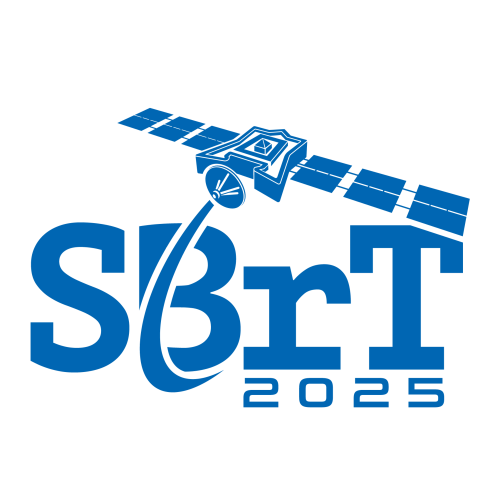
XLIII Simpósio Brasileiro de Telecomunicações e Processamento de Sinais
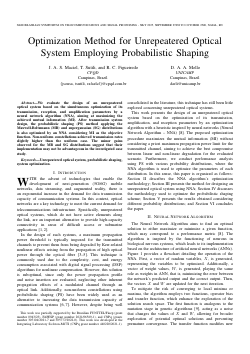
Optimization Method for Unrepeatered Optical System Employing Probabilistic Shaping
Júlia Aline Sousa Maciel, Tiago Sutili, Rafael C. Figueiredo, Darli Mello
DOI: 10.14209/sbrt.2025.1571144691
Keywords:
Abstract
We evaluate the design of an unrepeatered optical system based on the simultaneous optimization of its transmission, reception, and amplification parameters by a neural network algorithm (NNA), aiming at maximizing the achieved mutual information (MI). After transmission system design, the probabilistic shaping (PS) method applying the Maxwell-Boltzmann (MB) and supergaussian (SG) distributions is also optimized by an NNA considering MI as the objective function. Non-uniform constellations achieved transmission rates slightly higher than the uniform case. The minor gains observed for the MB and SG distributions suggest that their implementation may not be advantageous in the investigated case study.Download
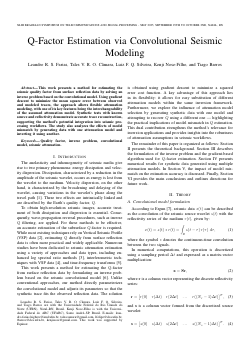
Q-Factor Estimation via Convolutional Seismic Modeling
Leandro R. S. Farias, Tales V. R. O. Câmara, Luiz F. Q. Silveira, Kenji Nose Filho, Tiago Barros
DOI: 10.14209/sbrt.2025.1571144698
Keywords:
Abstract
This work proposes a method for estimating the Q-factor from surface reflection data by formulating an inverse problem based on the convolutional model. The approach is flexible, allowing easy substitution of different attenuation models within the same framework. The Q-factor is estimated by minimizing a mean square error cost function using gradient descent. Additionally, we investigate the impact of model mismatch by generating data with one attenuation model and inverting it using another. This highlights the importance of model choice in Q-estimation and supports the method's potential integration into seismic processing workflows.Download
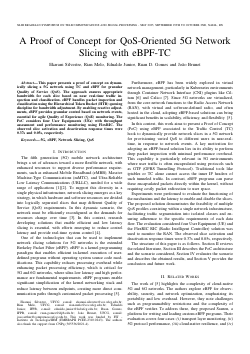
A Proof of Concept for QoS-Oriented 5G Network Slicing with eBPF-TC
Ekarani Silvestre, Rian Melo, Ruan Gomes, Ednaldo Junior, João Brunet
DOI: 10.14209/sbrt.2025.1571144703
Keywords:
Abstract
This paper presents a proof of concept on dynamically slicing a 5G network using TC and eBPF for granular Quality of Service (QoS). The approach ensures appropriate bandwidth for each slice based on near real-time traffic inspection and classification. eBPF handles packet inspection and classification using the Hierarchical Token Bucket (HTB) queuing discipline for bandwidth adjustment. By enabling reactive adjustments, eBPF provides granular control based on network events, essential for agile Quality of Experience (QoE) monitoring. The PoC considers four User Equipments (UEs) with throughput assessment and performance monitoring using FlexRIC. The observed slice activation and deactivation response times were 0.37s and 0.05s, respectively.Download
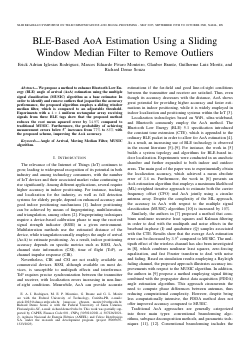
BLE-Based AoA Estimation Using a Sliding Window Median Filter to Remove Outliers
Erick Adrian Iglesias Rodriguez, Marcos Eduardo Pivaro Monteiro, Glauber Brante, Guilherme Luiz Moritz, Richard Demo Souza
DOI: 10.14209/sbrt.2025.1571144705
Keywords:
Abstract
We propose a method to enhance Bluetooth Low Energy (BLE) angle of arrival (AoA) estimation using the multiple signal classification (MUSIC) algorithm as a base estimator. In order to identify and remove outliers that jeopardize the accuracy performance, the proposed algorithm employs a sliding window median filter, which is compared to an adjustable threshold. Experiments with a 4x4 uniform rectangular array receiving signals from three BLE tags show that the proposed method reduces the root mean squared error by 54.9% compared to traditional MUSIC. Furthermore, the probability of achieving measurement errors below 5 degrees increases from 77% to 83% with the proposed scheme, improving the AoA accuracy.Download
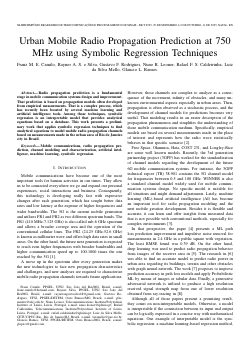
Urban Mobile Radio Propagation Prediction at 750 MHz using Symbolic Regression Techniques
Franz M. E. Camilo, Rayner Augusto Silva, Gustavo Rodrigues, Nuno R. Leonor, Rafael F. S. Caldeirinha, Luiz da Silva Mello, Glaucio L. Ramos
DOI: 10.14209/sbrt.2025.1571144717
Keywords:
Abstract
Radio propagation prediction is a fundamental stage in mobile communication systems design and improvement. That prediction is based on propagation models often developed from empirical measurements. That is a complex process, which has recently been boosted by several machine learning and artificial intelligence tools. Among those techniques, symbolic regression is an interpretable model that provides analytical equations based on a database. This work presents a preliminary work that applies symbolic regression techniques to find analytical equations to model mobile radio propagation channels based on measurements made in the urban area of Rio de Janeiro city in Brazil.Download
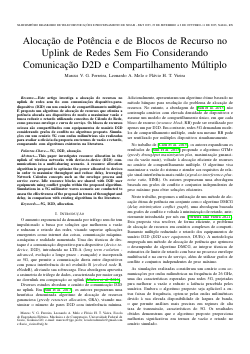
Alocação de Potência e de Blocos de Recurso no Uplink de Redes Sem Fio Considerando Comunicação D2D e Compartilhamento Múltiplo
Marcus Vinícius Gonzaga Ferreira, Leonardo Alves Moreira de Melo, Flavio Vieira
DOI: 10.14209/sbrt.2025.1571144728
Keywords: 5G D2D Alocação
Abstract
Este artigo investiga a alocação de recursos no uplink de redes sem fio com comunicações dispositivo-para-dispositivo (D2D) em um cenário de compartilhamento múltiplo. É proposto um algoritmo de alocação de recursos que otimiza a potência alocada aos dispositivos de modo a maximizar vazão e busca reduzir o retardo utilizando conceitos de Cálculo de Rede, como processo envelope e curva de serviço. Os blocos de recursos ociosos são compartilhados com equipamentos de usuário D2D considerando grafos de conflito no algoritmo proposto. Simulações em um cenário 5G com ondas milimétricas são realizadas para avaliar a eficácia da proposta em termos de vazão e retardo, comparando com algoritmos existentes na literatura.Download
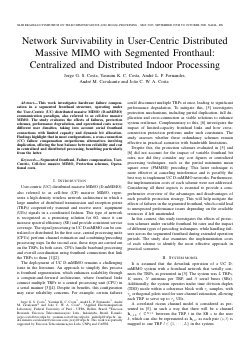
Network Survivability in User-Centric Distributed Massive MIMO with Segmented Fronthaul: Centralized and Distributed Indoor Processing
Jorge G. S. Costa, Yasmim K. C. Costa, André Fernandes, Andre Mendes Cavalcante, Joao Weyl Costa
DOI: 10.14209/sbrt.2025.1571144729
Keywords: Protection schemes UC D-mMIMO serial fronthaul dynamic bit allocation
Abstract
This work investigates protection schemes in User Centric (UC) distributed massive MIMO (D-mMIMO) networks with serial fronthaul connections under limited capacity, using dynamic bit allocation and different precoding techniques. The study evaluates the impact of failures, protection schemes, performance degradation, and operational costs across various user densities. Findings highlight the role of protection strategies in maintaining service quality over time, particularly under constrained fronthaul. The Cross-Connection (CC) scheme offers the best balance between reliability and cost, especially with distributed processing. Among all configurations, distributed CC outperforms alternatives involving duplication, making it the most scalable and cost-effective for high-density UC D-mMIMO.Download
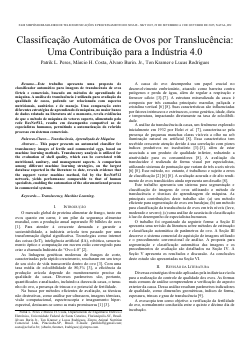
Classificação Automática de Ovos por Translucência: Uma Contribuição para a Indústria 4.0
Patrik L Peres, Marcio H Costa, Alvaro Burin, Ton Kramer, Lucas Rodrigues
DOI: 10.14209/sbrt.2025.1571144737
Keywords:
Abstract
This paper presents an automated classifier for translucency images of fertile and commercial eggs, based on machine learning methods. Translucency analysis is utilized for the evaluation of shell quality, which can be correlated with nutritional, sanitary, and management aspects. A comparison among different machine learning strategies, on the largest database reported in the literature to date, reveals evidence that the support vector machine method, fed by the ResNet512 network, yields performance comparable to that of human specialists, enabling the automation of the aforementioned process in commercial systems.Download
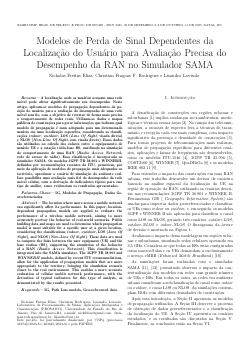
Modelos de Perda de Sinal Dependentes da Localização do Usuário para Avaliação Precisa do Desempenho da RAN no Simulador SAMA
Christian Rodrigues, Lisandro Lovisolo, Nicholas Freitas
DOI: 10.14209/sbrt.2025.1571144746
Keywords: 5G Modelos de Propagação Dados Georreferenciados
Abstract
A localização onde os usuários acessam uma rede móvel pode afetar significativamente o desempenho dessa rede. Neste artigo, são aplicados modelos de propagação que dependem da posição do usuário para avaliar o desempenho de uma rede móvel sem fio, com o objetivo de representar de forma mais precisa o comportamento das redes reais. Utilizam-se dados e mapas públicos de construções para gerar informações que indicam qual modelo de propagação é mais adequado para cada usuário em uma localização específica, considerando as classificações indoor, outdoor, LOS (Line of Sight, visada direta) e NLOS (Non-Line of Sight, sem visada direta). Esses dados são usados para calcular os enlaces entre o equipamento do usuário (UE) e a estação rádio-base (BS), auxiliando na simulação do comportamento de uma RAN (Rede de Acesso de Rádio). Essa classificação é incorporada ao simulador SAMA. Os modelos 3GPP TR 38.901 e WINNERII, definidos por recomendações recentes da ITU, permitem, por meio da aplicação de modelos de propagação mais adequados ao território, aproximar o cenário de simulação ao ambiente real. Isso possibilita uma avaliação mais precisa do desempenho da rede móvel celular, com a derivação de indicadores típicos para esse tipo de análise, como demonstram os resultados apresentados.Download
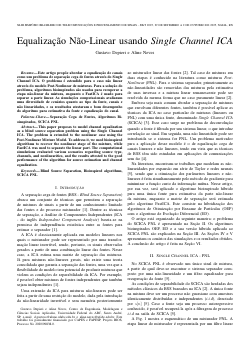
Equalização Não-Linear usando Single Channel ICA
Gustavo Fregonezi Depieri, Aline Neves
DOI: 10.14209/sbrt.2025.1571145532
Keywords:
Abstract
Este artigo propõe abordar a equalização de canais como um problema de separação cega de fontes através do Single Channel ICA. O problema é estendido para o caso não linear através do modelo Post-Nonlinear de misturas. Para a solução do problema, algoritmos bioinspirados são usados para recuperar a etapa não-linear da mistura, enquanto o FastICA é usado para separar a parte linear. As simulações computacionais avaliaram uma diversidade de cenários quanto ao tipo da fonte, canais e não linearidades, e os resultados atestaram o bom desempenho do algoritmo para estimativa da fonte e equalização do canal.Download